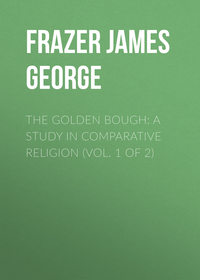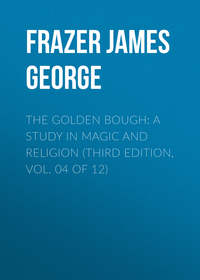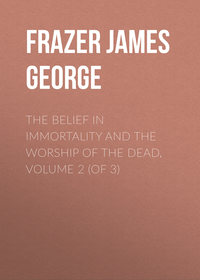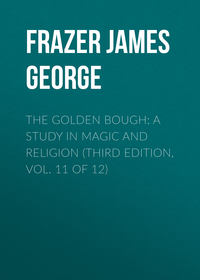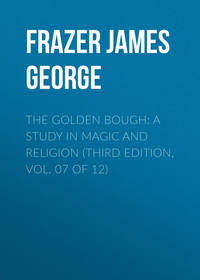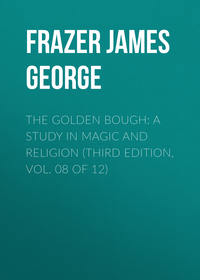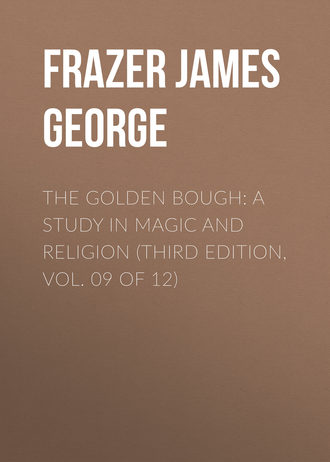
The Golden Bough: A Study in Magic and Religion (Third Edition, Vol. 09 of 12)
See above, p. 236.
599
Spirits of the Corn and of the Wild, ii. 325 sqq.
600
T. F. Thiselton Dyer, British Popular Customs (London, 1876), p. 32; County Folk-lore, Printed Extracts, No. 3, Leicestershire and Rutlandshire, collected and edited by C. J. Billson (London, 1895), pp. 93 sq.
601
Mrs. Lilly Grove (Mrs. J. G. Frazer), Dancing (London, 1895), pp. 147 sqq.; E. K. Chambers, The Mediaeval Stage (Oxford, 1903), i. 195 sqq.
602
As to the swords carried by the Perchten see above, p. 245; as to those carried by the dancers on Plough Monday, see J. Brand, Popular Antiquities of Great Britain (London, 1882-1883), i. 505. As to the sword-dance in general, see K. Müllenhoff, “Über den Schwerttanz,” in Festgaben für Gustav Homeyer (Berlin, 1871), pp. 111-147 (who compares the dances of the Salii); Mrs. Lilly Grove, op. cit. pp. 189 sqq., 211 sqq.; E. K. Chambers, op. cit. i. 182 sqq.
603
See below, pp. 331 sqq.
604
Plutarch, Quaest. conviv. vi. 8.
605
See above, pp. 143 sqq., 209.
606
Servius on Virgil, Aen. iii. 57, following Petronius; Lactantius Placidius, Commentarii in Statii Thebaida x. 793, p. 452, ed. R. Jahnke (Leipsic, 1898). According to the former writer, the scapegoat was cast out (“projiciebatur”); according to the latter, he was stoned to death by the people outside of the walls (“extra pomeria saxis occidebatur a populo”). The statement of some modern writers that he was killed by being hurled from a height rests on a reading (“praecipitabatur” for “projiciebatur”) in the text of Servius, which appears to have no manuscript authority and to be merely a conjecture of R. Stephan's. Yet the conjecture has been inserted in the text by F. Buecheler in his edition of Petronius (Third Edition, Berlin, 1882, p. 109) without any intimation that all the MSS. present a different reading. See the critical edition of Servius edited by G. Thilo and H. Hagen, vol. i. (Leipsic, 1881), p. 346.
607
Helladius, in Photius, Bibliotheca, p. 534 A, ed. Im. Bekker (Berlin, 1824); Scholiast on Aristophanes, Frogs, 734, and on Knights, 1136; Hesychius, Lexicon, s. v. φαρμακοὶ; compare Suidas, Lexicon, s. vv. κάθαρμα, φαρμακός, and φαρμακούς; Lysias, Orat. vi. 53. That they were stoned is an inference from Harpocration. See next note. When the people of Cyrene sacrificed to Saturn (Cronus), they wore crowns of fresh figs on their heads. See Macrobius, Saturn, i. 7. 25.
608
Harpocration, Lexicon, s. v. φαρμακός, who says δύο ἄνδρας ᾽Αθήνησιν ἐξῆγον καθάρσια ἐσομένους τῆς πόλεως ἐν τοῖς Θαργηλίοις, ἕνα μὲν ὑπὲρ τῶν ἀνδρῶν, ἕνα δὲ ὑπὲρ τῶν γυναικῶν. He does not expressly state that they were put to death; but as he says that the ceremony was an imitation of the execution of a mythical Pharmacus who was stoned to death, we may infer that the victims were killed by being stoned. Suidas (s. v. φαρμακός) copies Harpocration. As to the human scapegoats employed by the Greeks at the Thargelia and on other occasions see W. Mannhardt, Mythologische Forschungen (Strasburg, 1884), pp. 124 sqq.; J. Töpffer, Beiträge zur griechischen Altertumswissenschaft (Berlin, 1897), pp. 130 sqq.; August Mommsen, Feste der Stadt Athen im Altertum (Leipsic, 1898), pp. 468 sqq.; Miss J. E. Harrison, Prolegomena to the Study of Greek Religion, Second Edition (Cambridge, 1908), pp. 95 sqq.; M. P. Nilsson, Griechische Feste (Leipsic, 1906), pp. 105 sqq.; W. R. Paton, “The φαρμακοί and the Story of the Fall,” Revue Archéologique, iv. Série ix. (1907) pp. 51-57.
609
Ovid, Ibis, 467 sq.:
“Aut te devoveat certis Abdera diebusSaxaque devotum grandine plura petant,”
with the two scholia quoted respectively by M. P. Nilsson, Griechische Feste, p. 108 note 6, and by O. Schneider, in his Callimachea (Leipsic, 1870-1873), ii. 684. The scholiast refers to Callimachus as his authority.
610
Strabo, x. 2. 9, p. 542; Photius, Lexicon, s. v. Λευκάτης; L. Ampelius, Liber Memorialis, viii. 4; Servius, on Virgil, Aen. iii. 279; Ptolemaeus Hephaest., Nov. Histor. in Photius, Bibliotheca, cod. 190, p. 153, ed. Im. Bekker; Mythographi Graeci, ed. A. Westermann (Brunswick, 1843), pp. 198 sq. According to the manuscript reading in Photius, l. c., the priests flung themselves into the sea; but the reading has been altered by the editors. As to the Kumaon ceremony see above, pp. 196 sq.
611
Suidas and Photius, Lexicon, s. v. περίψημα. The word which I have translated “offscouring” (περίψημα) occurs in 1 Corinthians iv. 13, where it is similarly translated in the English version. It means properly that on which something is wiped off, like a sponge or a duster.
612
J. Tzetzes, Chiliades, v. 726-761 (ed. Th. Kiesseling, Leipsic, 1826). Tzetzes's authority is the satirical poet Hipponax. The tune which was played by the flutes while the man was being beaten is mentioned by Hesychius, s. v. Κραδίης νόμος. Compare id., s. v. Κραδησίτης; Plutarch, De musica, 8.
613
This may be inferred from the verse of Hipponax, quoted by Athenaeus, ix. 9, p. 370 b, where for φαρμάκου we should perhaps read φαρμακοῦ with Schneidewin (Poetae lyrici Graeci,3 ed. Th. Bergk, ii. 763).
614
W. Mannhardt, Mythologische Forschungen (Strasburg, 1884), pp. 113 sqq., especially 123 sq., 133.
615
Pliny, Nat. Hist. xx. 101; Dioscorides, De materia medica, ii. 202; Lucian, Necyom. 7; id., Alexander, 47; Theophrastus, Superstitious Man.
616
Theocritus, vii. 106 sqq. with the scholiast.
617
Compare Aug. Mommsen, Heortologie (Leipsic, 1864), pp. 414 sqq., id., Feste der Stadt Athen im Altertum (Leipsic, 1898), pp. 468 sq., 479 sqq.; M. P. Nilsson, Griechische Feste (Leipsic, 1906), pp. 105, iii sqq.; W. Mannhardt, Antike Wald- und Feldkulte (Berlin, 1877), p. 215.
618
At certain sacrifices in Yucatan blood was drawn from the genitals of a human victim and smeared on the face of the idol. See Diego de Landa, Relation des choses de Yucatan, texte espagnol et traduction française par l'Abbé Brasseur de Bourbourg (Paris, 1864), p. 167. Was the original intention of this rite to transfuse into the god a fresh supply of reproductive energy?
619
Aelian, Nat. Anim. ix. 26.
620
The Dying God, pp. 239 sq.
621
The Dying God, p. 114.
622
On the other hand, W. Mannhardt regarded the victims as representing the demons of infertility, dearth, and sickness, who in the persons of their representatives were thus hounded with blows out of the city. See his Mythologische Forschungen, p. 129.
623
W. R. Paton, “The φαρμακοί and the Story of the Fall,” Revue Archéologique, iv. Série, ix. (1907) pp. 51 sqq.
624
The Magic Art and the Evolution of Kings, ii. 313 sqq.
625
Dionysius Halicarnasensis, Antiquitates Romanae, ii. 56. 4. Compare Livy, i. 16. 4; Plutarch, Romulus, 27.
626
Spirits of the Corn and of the Wild, i. 248. Compare Adonis, Attis, Osiris, Second Edition, pp. 331 sqq.
627
See, for example, Helladius, cited by Photius, Bibliotheca, p. 534 a, ed. Im. Bekker, καὶ ἐκράτει τὸ ἔθος ἀεὶ καθαίρειν τὴν πόλιν τοῖς φαρμακοῖς; Harpocration, s. v. φαρμακός (vol. i. p. 298, ed. G. Dindorf), δύο ἄνδρας Ἀθήνησιν ἐξῆγον καθάρσια ἐσομένους τῆς πόλεως; Scholiast on Aristophanes, Knights, 1136, δημοσίους δέ, τοὺς λεγομένους φαρμακούς, οἵπερ καθαίρουσι τὰς πόλεις τῷ ἑαυτῶν φόνῳ.
628
Mr. Paton ingeniously suggests that in the Biblical narrative of Adam and Eve, who for eating a particular fruit were condemned to death and driven out of the happy garden with aprons of fig-leaves about their loins (Genesis iii.), we have a reminiscence of a custom of fertilizing fig-trees by a pair of human scapegoats, who, like the victims at the Thargelia, assimilated themselves to the tree by wearing its foliage or fruit. See W. R. Paton, “The φαρμακοί and the Story of the Fall,” Revue Archéologique, iv. Série, ix. (1907) pp. 55 sq.
629
Above, pp. 2, 186. Compare Plutarch, Parallela, 35, where a woman is represented as going from house to house striking sick people with a hammer and bidding them be whole.
630
W. Crooke, Popular Religion and Folk-lore of Northern India (Westminster, 1896), i. 99, 155; id., Tribes and Castes of the North-Western Provinces and Oudh (Calcutta, 1896), iii. 333, 441, 445.
631
A. Certeux et E. H. Carnoy, L'Algérie Traditionnelle (Paris and Algiers, 1884), p. 189.
632
H. Kern, “Een Spanisch schrijver over den godsdienst der heidensche Bikollers,” Bijdragen tot de Taal- Land- en Volkenkunde van Nederlandsch-Indië, xlvii. (1897) pp. 232 sq. The Spanish authority is Father José Castaño. An ancient Egyptian relief from Saqqarah represents a mummy at the entrance of the tomb, while the women tear out their hair and the men wave palm-branches, apparently to drive evil spirits away. The custom has been inherited by the modern Arabs, who similarly beat off the invisible foes with palm-branches. See A. Wiedemann, Herodots Zweites Buch (Leipsic, 1890), p. 347. However, in these cases the blows seem to be administered to the demons and not to the corpse.
633
J. M. van Baarda, “Ile de Halmaheira,” Bulletins de la Société d'Anthropologie de Paris, Quatrième Série, iii. (1892) p. 545. As to throwing a banana-trunk into the grave, see Spirits of the Corn and of the Wild, ii. 97.
634
Rev. J. Batchelor, The Ainu and their Folk-lore (London, 1901), p. 550.
635
Revue d'Ethnographie, iii. (1885) pp. 395 sq.
636
R. Schomburgk, Reisen in Britisch-Guiana (Leipsic, 1847-1848), ii. 457 sqq.; Rev. J. H. Bernau, Missionary Labours in British Guiana (London, 1847), p. 52; C. F. Ph. von Martius, Zur Ethnographie Amerika's, zumal Brasiliens (Leipsic, 1867), pp. 694 sq.; J. Crevaux, Voyages dans l'Amérique du Sud (Paris, 1883), p. 548.
637
Servius, on Virgil, Aen. i. 329. For more evidence see C. Boetticher, Der Baumkultus der Hellenen (Berlin, 1856), pp. 369 sqq.
638
See my note on Pausanias, ii. 31. 8, vol. ii. pp. 276 sqq.
639
V. Solomon, “Extracts from Diaries kept in Car Nicobar,” Journal of the Anthropological Institute, xxxii. (1902) p. 227.
640
J. de Acosta, History of the Indies, vol. ii. p. 375 (Hakluyt Society, London, 1880). See above, pp. 128 sqq.
641
P. Lozano, Descripcion Chorographica del terreno, rios, arboles, y animales de las dilatadissimas provincias del Gran Chaco, Gualamba, etc. (Cordova, 1733), p. 67. The reappearance of the Pleiades probably marked the beginning of the year for these people. See Spirits of the Corn and of the Wild, i. 307 sqq.
642
G. Osculati, Esplorazione delle regioni equatoriali lungo il Napo ed il fiume delle Amazzoni (Milan, 1850), p. 118.
643
H. Coudreau, Chez nos Indiens: quatre années dans la Guyane Française (Paris, 1895), p. 544.
644
G. H. Loskiel, History of the Mission of the United Brethren among the Indians in North America (London, 1794), Part i. p. 37.
645
The Satapatha Brahmana, v. 4. 4. 7, translated by J. Eggeling, Part iii. (Oxford, 1894) p. 108 (Sacred Books of the East, vol. xli.).
646
D. Chwolsohn, Die Ssabier und der Ssabismus (St. Petersburg, 1856), ii. 34.
647
On the positive benefits supposed in certain cases to flow from a beating compare S. Reinach, “La flagellation rituelle,” Cultes, Mythes et Religions, i. (Paris, 1905) pp. 180 sqq.; E. S. Hartland, Primitive Paternity (London, 1909-1910), i. 102 sqq.
648
Ch. Keysser, “Aus dem Leben der Kaileute,” in R. Neuhauss's Deutsch Neu-Guinea, iii. (Berlin, 1911) p. 124.
649
Father Lambert, “Mœurs et Superstitions de la tribu Bélep,” Les Missions Catholique, xii. (1880) p. 273; id., Mœurs et Superstitions des Néo-Calédoniens (Nouméa, 1900), p. 218.
650
F. J. de Santa-Anna Nery, Folk-lore Brésilien (Paris, 1889), p. 253.
651
R. Temesváry, Volksbräuche und Aberglauben in der Geburtshilfe und der Pflege des Neugeborenen in Ungarn (Leipsic, 1900), p. 8. Compare E. S. Hartland, Primitive Paternity (London, 1909-1910), i. 106.
652
A. C. Kruyt, “Het koppensnellen der Toradja's van Midden-Celebes, en zijne beteekenis,” Verslagen en Mededeelingen der Koninklijke Akademie van Wetenschappen, Afdeeling Letterkunde, iv. Reeks, iii. (Amsterdam, 1899) p. 199.
653
E. Beardmore, “The Natives of Mowat, Daudai, New Guinea,” Journal of the Anthropological Institute, xix. (1890) p. 464.
654
E. Westermarck, “The Popular Ritual of the Great Feast in Morocco,” Folk-lore, xxii. (1911) pp. 163-165.
655
See below, pp. 298, 302, 304.
656
E. Westermarck, op. cit. pp. 165 sq., 170, 178. The purificatory character of the rite is duly recognised by Dr. Westermarck (op. cit. p. 178).
657
J. G. v. Hahn, Albanesische Studien (Jena, 1854), i. 155.
658
W. H. D. Rouse, “Folk-lore from the Southern Sporades,” Folk-lore, x. (1899) p. 179.
659
K. Bartsch, Sagen, Märchen und Gebräuche aus Mecklenburg (Vienna, 1879-1880), ii. p. 258, § 1348.
660
J. F. L. Woeste, Volksüberlieferungen in der Grafschaft Mark (Iserlohn, 1848), pp. 25 sq.; A. Kuhn, Die Herabkunft des Feuers und des Göttertranks2 (Gütersloh, 1886), pp. 161 sqq. The ceremony takes its name of “quickening” from Quieke or Quickenbaum, a German name for the rowan-tree. Quicken-tree is also an English name for the rowan.
661
The Magic Art and the Evolution of Kings, ii. 52 sqq.
662
Rev. W. Gregor, Notes on the Folk-lore of the North-east of Scotland (London, 1881), p. 188.
663
A. Wuttke, Der deutsche Volksaberglaube2 (Berlin, 1869), p. 106, § 145.
664
J. F. L. Woeste, Volksüberlieferungen in der Grafschaft Mark (Iserlohn, 1848), p. 26. Compare A. Kuhn, Die Herabkunft des Feuers und des Göttertranks2 (Gütersloh, 1886), p. 179.
665
F. S. Krauss, Kroatien und Slavonien (Vienna, 1889), p. 108.
666
W. Mannhardt, Baumkultus, p. 257.
667
Th. Vernaleken, Mythen und Bräuche des Volkes in Österreich (Vienna, 1859), pp. 300 sq.; O. Freiherr von Reinsberg-Düringsfeld, Fest-Kalender aus Böhmen (Prague, preface dated 1861), pp. 163-167; A. Peter, Volksthümliches aus Österreichisch-Schlesien (Troppau, 1865-1867), ii. 285; J. A. E. Köhler, Volksbrauch, Aberglauben, Sagen und andre alte Überlieferungen im Voigtlande (Leipsic, 1867), pp. 173 sq.; M. Toeppen, Aberglauben aus Masuren2, (Danzig, 1867), pp. 69 sq.; A. Wuttke, Der deutsche Volksaberglaube2 (Berlin, 1869), p. 70, § 83; W. Mannhardt, Der Baumkultus (Berlin, 1875), pp. 258-263; W. Müller, Beiträge zur Volkskunde der Deutschen in Mähren (Vienna and Olmütz, 1893), pp. 322, 399 sq.; Dr. F. Tetzner, “Die Tschechen und Mährer in Schlesien,” Globus, lxxviii. (1900) p. 340; P. Drechsler, Sitte, Brauch und Volksglaube in Schlesien (Leipsic, 1903-1906), pp. 100 sq.; Alois John, Sitte, Brauche und Volksglaube im deutschen Westböhmen (Prague, 1905), pp. 67 sq. Mannhardt's whole discussion of what he calls “the Blow with the Rod of Life” (“Der Schlag mit der Lebensrute”) deserves to be studied. See his Baumkultus, pp. 251-303; and compare his treatment of the same theme, “Der Schlag mit dem Februum,” Mythologische Forschungen (Strasburg, 1884), pp. 113-153. The custom of “Easter Smacks” can be traced back to the twelfth century, when the practice was for women to beat their husbands on Easter Monday and for husbands to retaliate on their wives on Easter Tuesday. See J. Belethus, Rationale Divinorum Officiorum, cap. 120, appended to G. Durandus's Rationale Divinorum Officiorum (Lyons, 1584), p. 546 recto: “Notandum quoque est in plerisque regionibus secundo die post Pascha mulieres maritos suos verberare, ac vicissim viros eas tertio die quemadmodum licebat servis in Decembri dominos suos impune accusare.”
668
Alois John, Sitte, Brauch und Volksglaube im deutschen Westböhmen (Prague, 1905), pp. 5, 23 sq., 25, 28. Compare Th. Vernaleken, Mythen und Bräuche des Volkes in Österreich (Vienna, 1859), pp. 301 sq.
669
J. A. E. Köhler, Volksbrauch, Aberglauben, Sagen und andre alte Überlieferungen im Voigtlande (Leipsic, 1867), p. 174; W. Mannhardt, Baumkultus, pp. 264 sq.
670
August Witzschel, Sagen, Sitten und Gebräuche aus Thüringen (Vienna, 1878), pp. 181 sq.; W. Mannhardt, Baumkultus, p. 265. Compare G. Bilfinger, Unterschungen über die Zeitrechnung der alten Germanen, ii., Das Germanische Julfest (Stuttgart, 1901), pp. 85 sq.
671
The Magic Art and the Evolution of Kings, ii. 24 sq. It is highly significant that the heathen of Harran celebrated the marriage festival of all the gods and goddesses in the very month (March) in which the artificial fertilization of the date-palm was effected (D. Chwolsohn, Die Ssabier und der Ssabismus, St. Petersburg, 1856, ii. 36, 251). The frequency with which the artificial fertilization of the palm-tree by a mythical winged figure is represented on Assyrian monuments furnishes strong evidence of the religious and economic importance of the ceremony.
672
The Magic Art and the Evolution of Kings, i. 40 sqq., ii. 376 sqq.
673
J. de Acosta, The Natural and Moral History of the Indies (London, Hakluyt Society, 1880), ii. 323. I have modernized the spelling of the old English translator, whose version was originally published in 1604. Acosta resided both in Peru and Mexico, and published his work at Seville in 1590. It was reprinted in a convenient form at Madrid in 1894. Compare A. de Herrera, General History of the Vast Continent and Islands of America, translated by Captain John Stevens (London, 1725-1726), iii. 207 sq.
674
B. de Sahagun, Histoire Générale des Choses de la Nouvelle-Espagne, traduite par D. Jourdanet et R. Siméon (Paris, 1880), pp. 61 sq.: “On appelait le cinquième moi toxcatl. Au premier jour on faisait une grande fête en l'honneur du dieu appelé Titlacauan, autrement dit Tezcatlipoca, que l'on croyait être le dieu des dieux. C'était en son honneur que l'on tuait, le jour de sa fête, un jeune homme choisi… Cette fête était la principale de toutes, comme qui dirait la Pâque, et, en réalité, elle se célébrait aux environs de la Pâque de résurrection, ou quelques jours après.” Compare J. de Torquemada, Monarquia Indiana, lib. x. cap. 14, vol. ii. p. 256 (Madrid, 1723). As to Tezcatlipoca, the greatest of the Mexican gods, see J. G. Müller, Geschichte der amerikanischen Urreligionen (Bâle, 1867), pp. 613 sqq.; H. H. Bancroft, The Native Races of the Pacific States (London, 1875-1876), iii. 199 sqq., 237 sqq.; E. Seler, Altmexikanische Studien, ii. (Berlin, 1899) pp. 125 sqq. (Veröffentlichungen aus dem königlichen Museum für Völkerkunde, vol. vi. Heft 2/4).
675
On the twenty-third of April according to the Spanish text of Sahagun's work as translated in French by D. Jourdanet and R. Simeon (p. 52); the twenty-seventh of April according to the Aztec text of Sahagun's work as translated into German by Professor E. Seler (Altmexikanische Studien, ii. 194).
676
J. de Acosta, Natural and Moral History of the Indies (Hakluyt Society, London, 1880), ii. 378, 380; Diego Duran, Historia de las Indias de Nueva España (Mexico, 1867-1880), ii. 99, 101; Manuscrit Ramirez, Histoire de l'Origine des Indiens qui habitent la Nouvelle Espagne selon leurs traditions, publié par D. Charnay (Paris, 1903), pp. 159, 160 sq. According to Clavigero, the fifth Mexican month, in which the sacrifice of the human representative of Tezcatlipoca took place, began on the 17th of May (History of Mexico, translated by C. Cullen, London, 1807, i. 299); but this must be an error.
677
E. Seler, Altmexikanische Studien, ii. (Berlin, 1899) pp. 117 note 1, 121-125, 153 sq., 166 sq. (Veröffentlichungen aus dem königlichen Museum für Völkerkunde, vol. vi. Heft 2/4).
678
J. de Acosta, op. cit. ii. 380; Diego Duran, op. cit. ii. 101; Manuscrit Ramirez, Histoire de l'Origine des Indiens qui habitent la Nouvelle Espagne selon leurs traditions, publié par D. Charnay (Paris, 1903), p. 160; J. de Torquemada, Monarquia Indiana, lib. x. cap. 14, vol. ii. p. 257 (Madrid, 1723). I have modernized the spelling of Acosta's old translator (Edward Grimston).
679
B. de Sahagun, Histoire Générale des Choses de la Nouvelle Espagne, traduite par D. Jourdanet, et R. Siméon (Paris, 1880), pp. 61 sq., 96-99, 103; E. Seler, Altmexikanische Studien, ii. (Berlin, 1899), pp. 116-165, 194-209 (the latter passage contains the Aztec text of Sahagun's account with a German translation); J. de Acosta, The Natural and Moral History of the Indies (Hakluyt Society, London, 1880), pp. 350 sq.; Manuscrit Ramirez, Histoire de l'Origine des Indiens qui habitent la Nouvelle Espagne selon leurs traditions, publié par D. Charnay (Paris, 1903), pp. 157 sqq., 180 sq.; Diego Duran, Historia de las Indias de Nueva España (Mexico, 1867-1880), ii. 98-105; J. de Torquemada, Monarquia Indiana, lib. x. cap. 14, vol. ii. pp. 256 sqq. (Madrid, 1723); F. S. Clavigero, History of Mexico, translated by Charles Cullen, Second Edition (London, 1807), i. 300; Brasseur de Bourbourg, Histoire des Nations civilisées du Mexique et de l'Amérique-Centrale (Paris, 1857-1859), iii. 510-512; H. H. Bancroft, The Native Races of the Pacific States (London, 1875-1876), iii. 319 sq. According to Torquemada the flesh of the human victim was eaten by the elders “as a sacred and divine flesh”; but this is not mentioned by the other authorities of the sixteenth century cited above. Elsewhere (Spirits of the Corn and of the Wild, ii. 92 sq.) I cited this cannibal banquet as an example of a sacramental communion with the deity; but the silence of most early writers on the point makes it doubtful whether the custom has been correctly reported by Torquemada and later writers.


